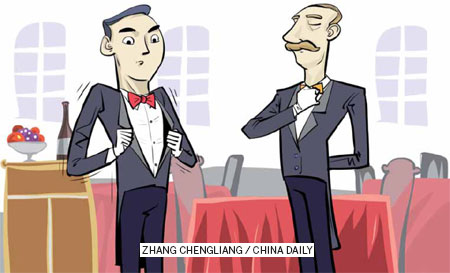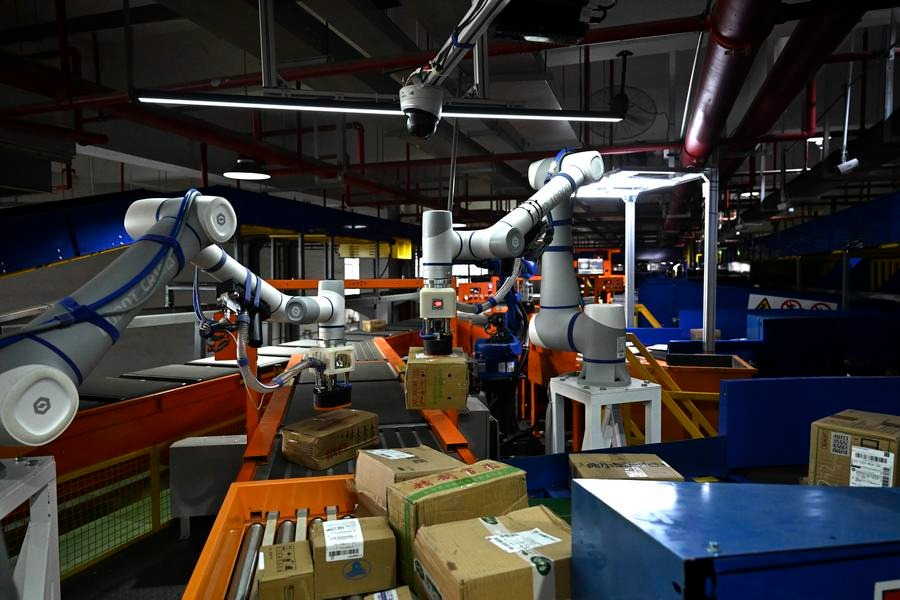Services sector holds the key to growth

China risks being marginalized by new international trade agreements unless it transforms industry base
China's manufacturing sector is open and market-oriented, but its services sector is closed and government-led. So, as the focus on world trade moves from traditional manufacturing to emerging service industries, China could be marginalized in new international trading agreements.
Thanks to China's reform and opening-up, it became the world's second-largest economy and the world's largest exporter in 2008. Some think it will soon surpass the US and become the world's biggest economy. But the glossy surface conceals inherent difficulties.
The Chinese government's reform and opening-up, in essence, is to open its manufacturing sector to domestic and foreign investors. Now, its countless products, ever decreasing in price, are sold around the world. But the government has barely opened up the service sector to investors, and because of lack of competition, services such as those in telecommunications, petroleum, logistics, education, healthcare, and finance, are expensive and inconvenient.

Competitiveness in developed countries is mainly in the service sector. As industries evolve, manufacturing is becoming lighter and services are becoming increasingly important. The functions of design, research and development, logistics, retail, advertising, finance, legal, personnel and IT, which originally belonged to manufacturing, are being outsourced. Services which constantly absorb skilled professionals will greatly increase competitiveness of a country and can be reclassified as a knowledge industry.
As the manufacturing sector increasingly relies on machines and is reduced to processing plants, the knowledge industry is creating more jobs and distributing more high value-added products, such as energy saving plans, environmental protection technologies, IT solutions, industry standards, design patents, inventions, brands, data mining and so on. The knowledge industry can be regarded as the most important source of national wealth, and even as the future of a nation.
The development of the knowledge industry requires a better business environment, including a more open market, with fairer competition, better protection of property rights and those of employees, and minimal intervention of government.
According to statistics, services are responsible for more than 80 percent of the United States' GDP, in which knowledge-based industries grew especially fast. It is the same in other developed countries. To develop knowledge industries has become strategically important for them, and they have incentives to create new global rules to globalize trade and investment in the service sector.
With the traditional WTO framework - subject to difficulties in negotiations between countries which have developed service sectors and those with underdeveloped ones - making little progress over the past decade and becoming more outdated, developed economies, such as the US, the EU and Japan, began to leave aside the BRICS nations in developing a new generation of international trade standards.
Led by the US, the past few years have seen accelerated development of these standards, and once a new system is formed, the WTO may be completely marginalized.
Not surprisingly, the core of the new generation is investment and trade of services, and mainly center around three agreements under negotiation - PSA, TPP and TTIP.
The Plurilateral Services Agreement, which has 21 members, including the US, Japan and Europe, and whose service sector accounts for two-thirds of world services, will be completed by the end of this year. PSA future negotiations will mainly include financial services, express delivery, distribution, telecommunications, e-commerce, transportation, tourism, networking, mobile communications networks and the Internet, all of which fall in service sector.
The Trans-Pacific Partnership Agreement, a proposed free trade agreement among Australia, Brunei, Chile, Canada, Japan, Malaysia, Mexico, New Zealand, Peru, Singapore, the US and Vietnam, is ostensibly intended to be a "high-standard" agreement specifically aimed at emerging trade issues, such as barriers to trade, trade in services, intellectual property, government procurement and competition policy.
The Transatlantic Trade and Investment Partnership is a proposed free trade area between the US and EU, representing potentially the largest free trade area in history, covering 46 percent of world GDP, and accounting for a large share of world trade and foreign direct investment.
These three partnership agreements have become the key to economic development in the new era, and will reshape the strategic situation in globalization by improving the competitiveness of its members, while other countries may be marginalized.
There are only two options for China: to participate or to reduce the impact of three partnerships.
While other countries are engaged in intense negotiations, China was absent. This is understandable in that the ratio of China's service industry to GDP in 2012 was only 47 percent - much of it from monopoly gains in finance and telecom - and the entire industry may be uncompetitive. If the service sector is opened to foreign investors, not only could the monopoly interests be broken, the entire sector could be shaken up.
A more crucial reason for China's absence is its difficulty in meeting the "high standards" required in these agreements. For example, the fair competition and protection of property rights in services that the PSA emphasizes will not be easy to achieve.
If China stays outside of these agreements, which unfortunately will be the case for the foreseeable future, it will bear high risk. Although China's trade dependence, affected by impact of the sub-prime crisis, dropped to about 47 percent in 2012, the number is still about double of that of most developed countries. As a former winner in globalization, China cannot afford being excluded from global trade or continue dealing with a variety of trade barriers.
China must take action to reduce the cost of being excluded from the new edition of WTO.
In the short term, the country must continue bilateral negotiations in order to stabilize the existing framework, and promote the Shanghai Free Trade Area in order to join the TPP and PSA.
First, China needs to continue to deepen the China-US strategic and economic negotiations and continue to strengthen cooperation with Japan and South Korea, ASEAN and the EU. Second, China can use a free trade area as the negotiating body to participate in the negotiations of PSA and TPP.
In this way, China not only can soften the impact of opening up investment and services and reduce political resistance by domestic interest groups, but also can participate in the formulation of rules. When the Shanghai FTA has learned replicable experiences, the zone can be extended to other areas or even the entire country.
In the long term, China needs to learn the conditions and rules of the new game and work hard to achieve those conditions. Its biggest threat may be the possibility that it is subject to review of market economy status by the US. Without market economy status, China can be excluded from the game of globalization in the new era.
The first task for China, then, may be to turn the investment-oriented government into a service-oriented government. The government should especially break monopolies in the service sector and open it to domestic private investors to foster competitiveness in the knowledge industry.
There may be a long way to go before China can return to the center of the world stage.
The author is a lecturer at the Management School of Shanghai University and a research fellow at the China Europe International Business School Lujiazui International Finance Research Center. The views do not necessarily reflect those of China Daily.

(China Daily Africa Weekly 01/03/2014 page12)
Today's Top News
- Japan unqualified for UN Security Council: Chinese envoy
- Deforestation is climate action's blind spot
- Japan unqualified for UN Security Council: Chinese envoy
- China, Germany reach outcomes after discussions
- Chinese cities dominate global science hub rankings
- Japan's tourism battered as Chinese travelers cancel trips






























